Beautiful Plants For Your Interior
20 British Garden Birds Identification: A Beginner’s Guide
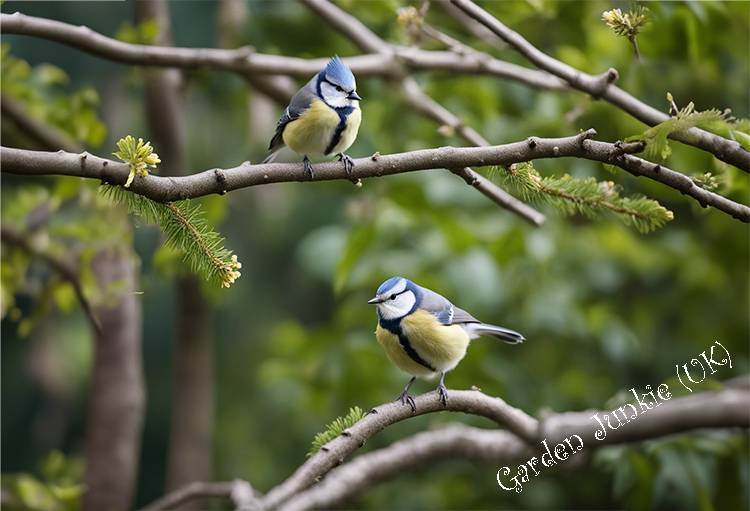
This British Garden Birds Identification guide will help beginners easily identify some of our wonderful, but common British birds and in particular our garden birds, which are a regular sight in our gardens for many people across the UK. These feathered visitors along with our butterflies and bees, bring life and colour to our gardens.
British Garden Bird Identification
Identifying our common British birds and their amazing sounds, butterflies and bees can enhance our appreciation of the natural world around us. With over 632 UK bird species being recorded to date across the country, with, just over 200 of these species having been recorded in or around our gardens.
By learning to identify some of the most common species of British garden birds it can make bird watching in your garden both enjoyable and rewarding as you learn to recognise the various species that frequent your garden, and surrounding areas like the local park.
From the iconic robin with its red breast to the charming blue tit and the striking goldfinch, there is a diverse array of bird species that can be spotted in British gardens. Learning to identify these birds can involve observing their physical characteristics, behaviour, and song.
In this post we will explore some of the key features of 20 of the most common garden birds in the UK, providing tips and guidance to help you confidently recognise and appreciate these avian visitors to your garden.
Common British Garden Birds
(Click on the links below to take you to the birds)
1. European Robin (Erithacus rubecula)
2. Northern Long-Tailed Tit (Aegithalos caudatus)
3. Eurasian Blue Tit (Cyanistes caeruleus)
4. Eurasian Chaffinche (Fringilla coelebs)
5. House Sparrow (Passer domesticus)
6. Wood Pigeon (Columba palumbus)
7. Eurasian Bullfinch (Pyrrhula pyrrhula)
8. Goldcrest (Regulus regulus)
9. Great Tit (Parus major)
10. Starling (Sturnus vulgaris)
11. European Gold Finch (Carduelis carduelis)
12. Eurasian Jay (Garrulus glandarius)
13. Great Spotted Woodpecker (Dendrocopos major)
14. Common Blackbird (Turdus merula)
15. Eurasian Collared Dove (Streptopelia decaocto)
16. Greenfinch (Chloris chloris)
17. Eurasian Magpie (Pica pica)
18. Yellow Hammer (Emberiza citrinella)
19. Jackdaw (Corvus monedula)
20. Carrion Crow (Corvus corone)
Table of Contents
1. European Robin (Erithacus rubecula)
The European Robin (Erithacus rubecula) is a small bird species that is well-known for its distinctive orange-red breast and face. This bird is a common sight in gardens and woodlands across Europe and parts of western Asia. The European Robin is known for its melodious song, often being one of the first birds to sing at dawn and the last to sing at dusk. Despite its small size, the European Robin is highly territorial and will fiercely defend its feeding and nesting grounds from other robins and intruders.
One interesting fact about the European Robin is its association with folklore and mythology. In many cultures, the robin is considered a symbol of good luck and joy, and it has often been depicted in folklore and literature as a friendly and helpful bird. Additionally, the European Robin as we all know has been associated with Christmas in the UK, and it is a popular motif on Christmas cards and decorations.
The European Robin is also known for its fearless behaviour around humans. It is often seen approaching gardeners to investigate freshly turned soil for potential food, and it may even perch on a gardener’s spade or fork to catch any unearthed insects. This bold and inquisitive nature has earned the European Robin a special place in the hearts of many birdwatchers and nature enthusiasts.
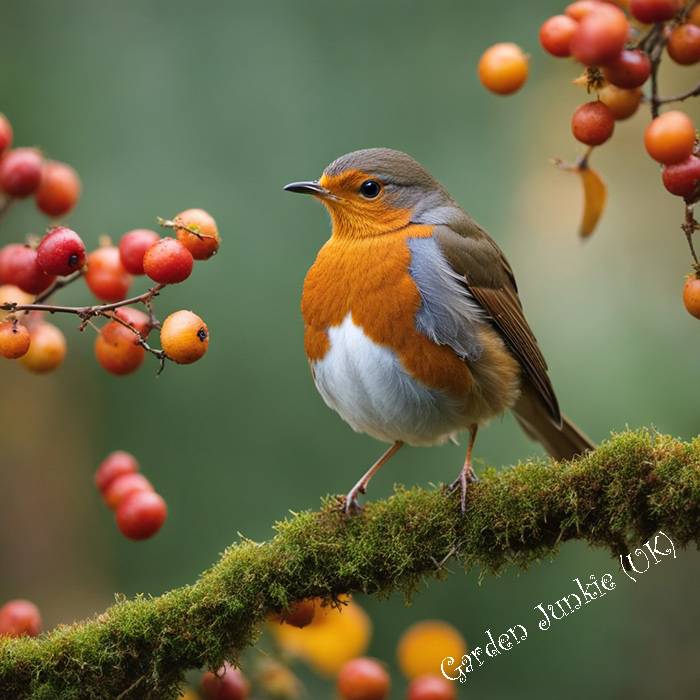
Photos of British Garden Birds: European Robin (Erithacus rubecula)
Length: 12–14cm
Wingspan: 20-22cm
Weight: 16-22grams
Song: European Robin (Erithacus rubecula)
2. Northern Long-Tailed Tit (Aegithalos caudatus)
The Long-tailed Tit (Aegithalos caudatus) is a small, adorable bird with a distinctive appearance characterised by its long tail, round body, and tiny beak. This species is widespread across Europe and Asia, often found in woodlands, parks, and gardens. Long-tailed Tits are known for their sociable nature, as they often form small, lively flocks consisting of family members and other birds during the non-breeding season. These flocks move together through the trees, emitting high-pitched contact calls to stay in touch with each other.
One fascinating aspect of the Long-tailed Tit is its unique nest-building behaviour. The birds construct intricate, dome-shaped nests using moss, lichen, spider webs, and feathers, which are then lined with more feathers for insulation. Both the male and female construct the nest, and it is often so well camouflaged and compact that it can be mistaken for a clump of moss or lichen. This remarkable construction not only protects from the elements but also helps to conceal the nest from potential predators.
Long-tailed Tits have a varied diet, feeding primarily on insects and spiders during the breeding season, and then switching to a combination of insects and seeds during the winter months. They are agile foragers, flitting from branch to branch in search of their prey. Their small size and acrobatic movements make them a delight to watch as they manoeuvre through the foliage in pursuit of food.
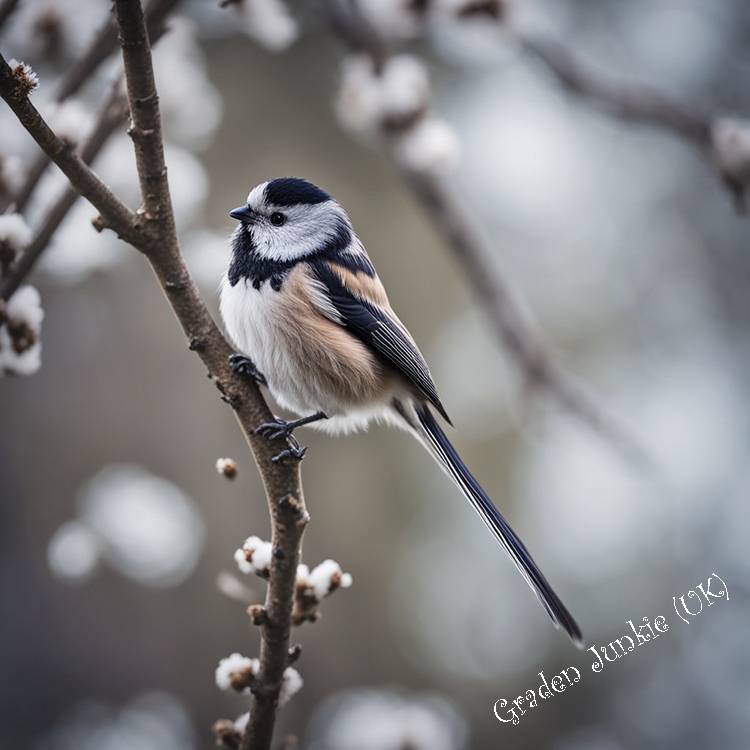
Photos of British Garden Birds: Northern Long-tailed Tit (Aegithalos caudatus)
Length: 13–15cm
Wingspan: 16-19cm
Weight: 7-10 grams
Song: Northern Long-tailed Tit (Aegithalos caudatus)
3. Eurasian Blue Tit (Cyanistes caeruleus)
The Eurasian Blue Tit (Cyanistes caeruleus) is a small and vibrant bird species found across Europe and parts of Asia. Known for its striking blue and yellow plumage, the Blue Tit is a common sight in woodlands, gardens, and parks. These agile birds are highly adaptable and can be spotted flitting between branches and foliage in search of insects and seeds. Blue Tits are also frequent visitors to bird feeders, where they display their acrobatic skills while obtaining food.
One fascinating aspect of the Blue Tit is its nesting behaviour. These birds construct their nests in tree holes, crevices, or man-made nest boxes using a variety of materials such as moss, feathers, and hair. The female Blue Tit meticulously lines the nest with soft materials to create a cosy environment for her eggs and chicks. Additionally, Blue Tits are known for their ability to adapt to urban environments, often nesting in garden nest boxes and even utilising unconventional nesting sites such as letterboxes and drainpipes.
Blue Tits are renowned for their intelligence and problem-solving abilities. In studies, these birds have demonstrated remarkable cognitive skills, such as learning to open milk bottle caps to access the cream inside. Their adaptability and quick learning make them a subject of interest for researchers studying avian cognition and behaviour. Additionally, Blue Tits are known to form mixed-species foraging flocks during the non-breeding season, cooperating with other bird species to locate food and increase foraging efficiency.
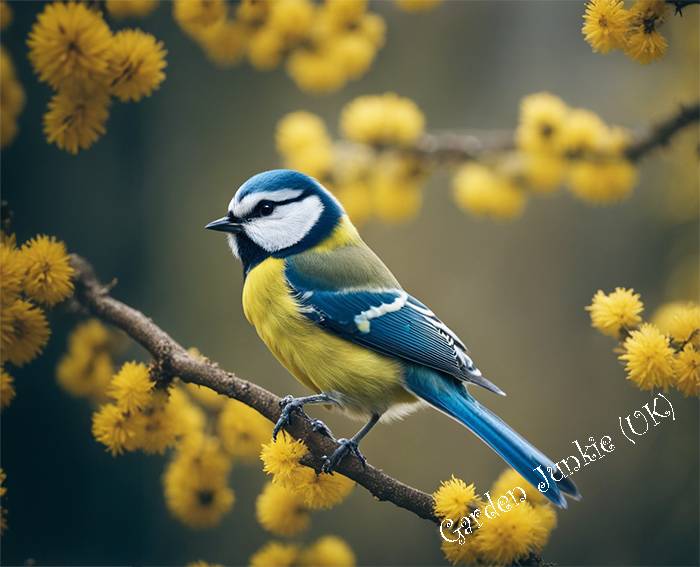
Photos of Common British Birds: Eurasian Blue Tit (Cyanistes caeruleus)
Length: 11-12cm
Wingspan: 18-20cm
Weight: 8-11 grams
Song: Eurasian Blue Tit (Cyanistes caeruleus)
4. Eurasian Chaffinch (Fringilla coelebs)
The Eurasian Chaffinch (Fringilla coelebs) is a widespread small passerine bird found throughout Europe, western Asia, and parts of North Africa. This colourful bird is known for the striking contrast between its pink breast and slate-blue crown, as well as its white wing bars and prominent white outer tail feathers. The male chaffinch is particularly eye-catching during the breeding season, with its vibrant plumage and melodious song, while the female exhibits more subdued colours, providing effective camouflage during nesting.
Chaffinches are primarily seed-eaters, with a diet consisting of various seeds, grains, and berries. They are often observed foraging on the ground or perched in trees, using their strong bills to crack open seeds and extract the nutritious kernel. During the breeding season, chaffinches also incorporate insects and caterpillars into their diet, providing essential protein for their growing chicks.
One interesting aspect of chaffinch behaviour is their migratory patterns. While some populations are sedentary, many chaffinches undertake seasonal migrations, with individuals from northern and central Europe travelling south to milder regions for the winter. These migrations can involve significant distances, and chaffinches are known for their punctual arrival at their breeding and wintering grounds, often following the same routes year after year. This remarkable navigation ability is thought to be guided by a combination of innate instincts and environmental cues.
Chaffinches are also known for their adaptability to various habitats, including woodlands, parks, gardens, and farmland. Their diverse diet and ability to thrive in different environments have contributed to their widespread distribution across their range. Additionally, chaffinches are highly social birds, often forming mixed-species flocks with other finches and small songbirds, particularly during the non-breeding season. These social interactions provide opportunities for shared foraging and predator vigilance, benefiting the entire group.

British Garden Birds Identification: Eurasian Chaffinch (Fringilla coelebs)
Length: 12cm
Wingspan: 24.5-28.5cm
Weight: 18-29 grams
Song: Eurasian Chaffinch (Fringilla coelebs)
5. House Sparrow (Passer domesticus)
The House Sparrow (Passer domesticus) is a small, chunky bird that is native to Eurasia and North Africa but has successfully adapted to urban, suburban, and agricultural environments worldwide. These adaptable birds are often found in close association with human habitation, where they forage for food and seek shelter in buildings, parks, and gardens. House Sparrows are highly social and gregarious, often forming large flocks, particularly during the non-breeding season when they congregate in communal roosts.
One intriguing aspect of House Sparrow’s behaviour is their vocal communication. These birds are known for their lively and varied vocalisations, consisting of chirps, chattering, and melodious songs. Males may engage in spirited singing to establish and defend their territories, while females also vocalise to communicate with their mates and offspring. The diverse repertoire of vocalisations plays a crucial role in social interactions and maintaining group cohesion within sparrow communities.
House Sparrows are opportunistic feeders with a varied diet that includes seeds, grains, insects, and human food scraps. Their ability to exploit a wide range of food sources has contributed to their success in human-altered landscapes. These birds are often seen foraging on the ground, searching for seeds and invertebrates, or visiting bird feeders to supplement their diet. Additionally, House Sparrows are known to engage in dust bathing, a behaviour where they vigorously fluff and shake their feathers in loose soil or dust, which helps to maintain feather condition and control parasites.
The House Sparrow has a long history of association with human culture and urban life. These birds have been depicted in art, literature, and folklore, often symbolising traits such as resilience, adaptability, and communal living. While they are celebrated for their familiarity and ubiquity in human environments, House Sparrows have also faced population declines in some regions, leading to conservation efforts to understand and address the factors impacting their numbers.
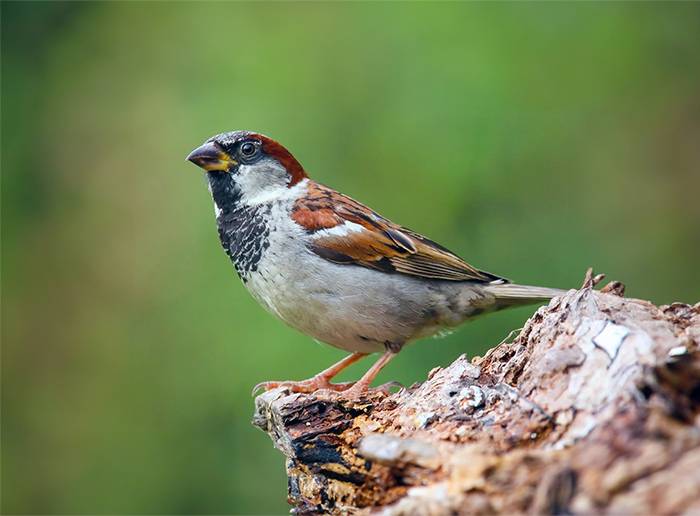
Photos of British Garden Birds: House Sparrow (Passer domesticus)
Length: 16-18cm
Wingspan: 21-21.5cm
Weight: 24-39.5grams
Song: House Sparrow (Passer domesticus)
6. Wood Pigeon (Columba palumbus)
The Wood Pigeon (Columba palumbus) is a large and widespread species of pigeon found across Europe, western Asia, and parts of North Africa. These birds are known for their distinctive appearance, characterised by a pinkish breast, subtle iridescent plumage, and prominent white patches on the neck and wings. Woodpigeons are a familiar sight in both rural and urban environments, where they can often be observed foraging for food in woodlands, parks, gardens, and agricultural areas.
One interesting aspect of Wood Pigeon’s behaviour is their feeding habits. These birds primarily feed on seeds, grains, and fruits, and are particularly fond of consuming crops such as cereals and brassicas. As ground feeders, Wood Pigeons are adept at foraging for fallen seeds and grains, using their strong bills to crack open hard shells and extract the nutritious contents. Their feeding activities can sometimes lead to conflicts with farmers and gardeners due to their consumption of agricultural produce.
Wood Pigeons are known for their distinctive cooing calls, which are often heard during the breeding season as males establish and defend their territories. The deep, resonant cooing is a characteristic sound of the countryside and adds to the ambience of rural landscapes. Additionally, Woodpigeons are capable of swift and agile flight, often soaring and gliding with grace and precision. Their large size and elegant flight patterns make them a notable presence in the skies.
During the breeding season, Wood Pigeons construct relatively simple nests made of twigs and plant materials, often located in trees or shrubs. The female typically lays two white eggs, and both parents take turns incubating the eggs and caring for the young. Wood Pigeons have a relatively high reproductive potential, with the ability to raise multiple broods in a single breeding season under favourable conditions. Their adaptability and reproductive success contribute to their status as one of the most abundant and widespread bird species in their range.
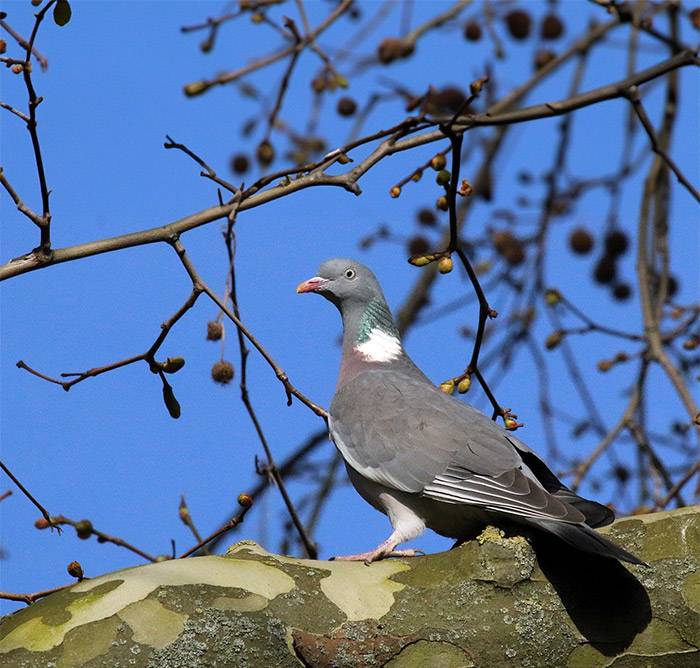
Photos of British Garden Birds: Wood Pigeon (Columba palumbus)
Length: 40-42cm
Wingspan: 75-80cm
Weight: 480-550grams
Song: Wood Pigeon (Columba palumbus)
7. Bullfinch (Pyrrhula pyrrhula)
The Bullfinch (Pyrrhula pyrrhula) is a charismatic and colourful bird species found across Europe and parts of Asia. Renowned for its striking appearance, the male Bullfinch features a distinctive black cap, vibrant pink-red breast, and grey back, while the female displays more subdued plumage with a pinkish-brown tone. These birds are often found in woodlands, hedgerows, and gardens, where they forage for seeds, buds, and small fruits. The Bullfinch’s preference for feeding on the buds of fruit trees has led to occasional conflicts with orchard owners, as their foraging activities can impact crop yields.
One fascinating aspect of Bullfinch’s behaviour is their soft, melancholic song, which is often described as a plaintive whistle. The male Bullfinch’s song is a gentle, flute-like melody, typically heard during the breeding season as he establishes and defends his territory. The female also produces calls and soft contact notes, particularly during nesting and parental care. Their vocalisations contribute to the tranquil ambience of woodlands and other habitats where Bullfinches are present.
Bullfinches are also known for their shy and elusive nature, often remaining hidden within foliage and thickets. Despite their discreet behaviour, these birds are highly territorial during the breeding season, with males vigorously defending their chosen territories from intruders. Additionally, Bullfinches are monogamous and form strong pair bonds, with both parents contributing to nest building, incubating the eggs, and raising the young. Their dedication to parental care and the formation of stable pair bonds are key aspects of their breeding biology and social structure.
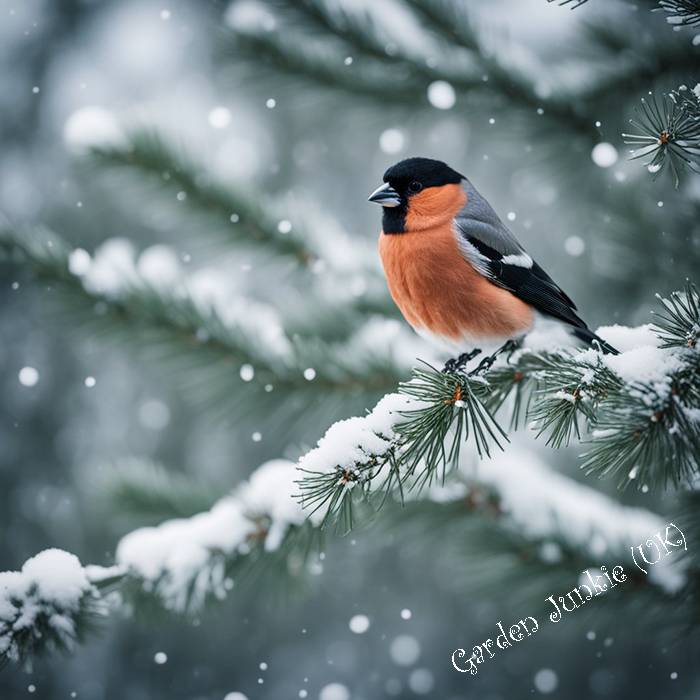
Photos of British Garden Birds: Eurasian Bullfinch (Pyrrhula pyrrhula)
Length: 14.5-16.5cm
Wingspan: 22-26cm
Weight: 21-27grams
Song: Eurasian Bullfinch (Pyrrhula pyrrhula)
8. Goldcrest (Regulus regulus)
The Goldcrest (Regulus regulus) is a diminutive yet captivating bird with the title of the smallest bird species in Europe. With its vibrant green and yellow plumage, the Goldcrest is a striking sight in the woodlands and coniferous forests it frequents. Despite its small size, this bird is known for its remarkable agility and acrobatic movements as it forages for insects and spiders among the foliage. Its high-pitched, melodic song, often described as a series of trills and high notes, adds to the enchanting ambience of its woodland habitats.
One fascinating aspect of Goldcrest’s behaviour is its remarkable migratory journey. Despite its small stature, the Goldcrest embarks on an impressive migration from its breeding grounds in northern and central Europe to wintering sites in southern and western Europe. Some individuals even undertake longer migrations to the British Isles, demonstrating the bird’s resilience and adaptability. This migratory feat showcases the incredible determination and endurance of the Goldcrest as it travels vast distances to find suitable wintering grounds.
The Goldcrest’s nesting habits are equally intriguing. These birds construct delicate, cup-shaped nests using materials such as moss, lichen, and spider silk, typically positioned high in the branches of coniferous trees. The female Goldcrest is responsible for incubating the eggs, while the male assists in providing food for the female during this period. The Goldcrest’s nesting strategy and choice of habitat reflect its preference (but not solely) for coniferous woodlands, where it finds ample food and suitable nesting sites to raise its young.

Photos of British Garden Birds: Goldcrest (Regulus regulus)
Length: 9cm
Wingspan: 14cm
Weight: 6-7 grams
Song: Goldcrest (Regulus regulus)
9. Great Tit (Parus major)
The Great Tit (Parus major) is a familiar and charismatic bird species found across Europe and parts of Asia. Renowned for its striking appearance, the Great Tit boasts a distinctive black head with a prominent white cheek patch, contrasting with its greenish-yellow body. This bird is roughly the same size as a European Robin, making it a noticeable presence in woodlands, gardens, and urban areas. Great Tits are highly adaptable and have readily adjusted to man-made habitats, making them a common sight in bird feeders and urban green spaces.
One fascinating aspect of Great Tit’s behaviour is their diverse diet and foraging techniques. These birds are active foragers, probing trees and shrubs for insects and larvae, while also hopping along the ground in search of fallen seeds and nuts. Their versatile feeding habits also include visiting bird feeders to consume seeds and suet, making them a popular subject for birdwatchers and wildlife enthusiasts. The Great Tit’s ability to exploit various food sources contributes to its widespread distribution and success in diverse habitats.
Great Tits are known for their complex and melodious songs, which play a crucial role in territorial defence and courtship displays. The male Great Tit’s song is a rich and varied melody, consisting of trills, whistles, and repetitive notes, often heard during the breeding season as he establishes and defends his territory. Additionally, Great Tits communicate through a range of calls and vocalizations, conveying information about potential threats, food availability, and social interactions within the flock. Their vocal repertoire and communication skills are essential for maintaining social cohesion and reproductive success within their communities.
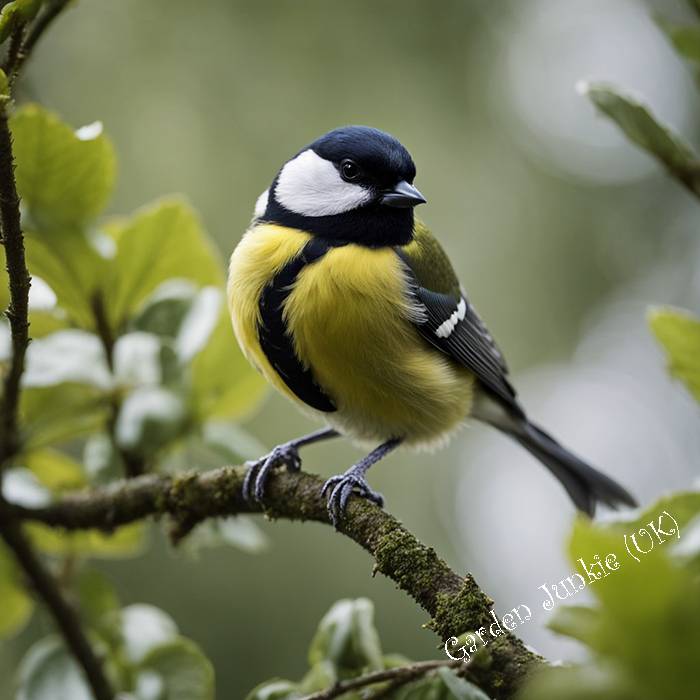
Photos of British Garden Birds: Great Tit (Parus major)
Length: 14cm
Wingspan: 24cm
Weight: 18 grams
Song: Great Tit (Parus major)
10. Starling (Sturnus vulgaris)
The Starling (Sturnus vulgaris) is a highly adaptable and sociable bird species known for its iridescent plumage and remarkable vocal abilities. In its breeding plumage, the adult Starling displays glossy black feathers with a metallic sheen, adorned with purple and green iridescence. These birds are renowned for their exceptional vocal mimicry, capable of imitating a wide array of sounds, including other bird species, mechanical noises, and even human speech. This mimicry is particularly prominent during the breeding season when males use their diverse vocal talents to attract mates and establish territories.
One fascinating aspect of Starling’s behaviour is their mesmerising aerial displays known as murmurations. These stunning formations occur when large flocks of Starlings engage in intricate and synchronised flight patterns, creating breathtaking shapes and movements across the sky. The murmurations serve multiple purposes, including predator avoidance, information sharing about food sources, and social bonding among the flock members. Witnessing a murmuration is a captivating natural spectacle that showcases the coordination and communication skills of these birds.
Starlings are opportunistic feeders with a diverse diet that includes insects, fruits, seeds, and even human-provided food such as scraps and bird feed. Their adaptability and omnivorous diet have contributed to their successful colonisation of diverse habitats, from urban areas to agricultural landscapes. However, their foraging habits, particularly in large flocks, can lead to conflicts with other bird species and human activities, making them a subject of both admiration and concern in various ecological contexts.
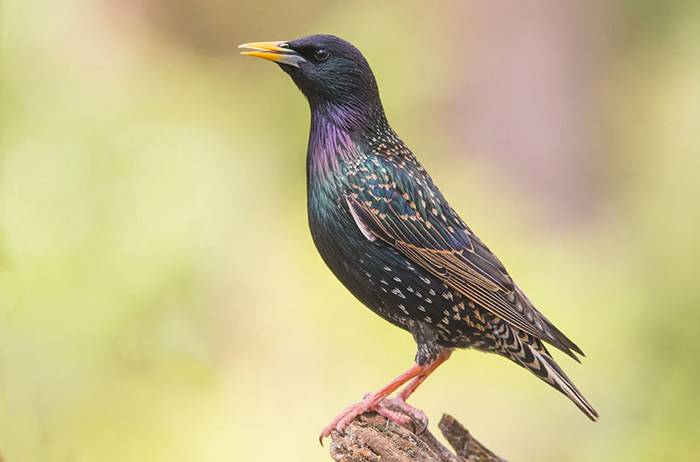
Photos of British Garden Birds: Starling (Sturnus vulgaris)
Length: 20-23cm
Wingspan: 37-42cm
Weight: 75-90 grams
Song: Starling (Sturnus vulgaris)
11. European Goldfinch (Carduelis carduelis)
The European Goldfinch (Carduelis carduelis) is a charming and colourful bird species known for its vibrant plumage and delightful song. With its striking red face, black and white head, and golden wing and tail feathers, the European Goldfinch is a visually captivating sight. Its melodious, tinkling song, often described as a series of trills and twittering notes, adds to the enchanting ambience of its preferred habitats, including gardens, meadows, and open woodlands. This bird’s distinctive appearance and cheerful song make it a favourite among birdwatchers and nature enthusiasts.
One fascinating aspect of European Goldfinch behaviour is its dietary preferences, particularly its fondness for thistle seeds. These birds are adept at extracting seeds from the heads of thistles using their specialised beaks, showcasing their remarkable foraging skills. In addition to seeds, European Goldfinches also consume a variety of plant materials, such as buds, flowers, and berries, as well as occasional insects and spiders. Their diverse diet and foraging techniques contribute to their adaptability and success in a range of habitats, from rural farmlands to urban gardens.
European Goldfinches are highly social birds and often form small, chattering flocks, especially during the non-breeding season. These flocks engage in lively interactions, displaying aerial acrobatics and engaging in communal foraging activities. Their gregarious nature and vocal communication contribute to the lively and dynamic atmosphere of their gatherings, creating a sense of camaraderie among the flock members. The European Goldfinch’s social behaviour and vibrant presence add a touch of liveliness to the natural landscapes they inhabit.

Photos of British Garden Birds: European Goldfinch (Carduelis carduelis)
Length: 12-13cm
Wingspan: 21-25.5cm
Weight: 14-19 grams
Song: European Goldfinch (Carduelis carduelis)
12. Eurasian Jay (Garrulus glandarius)
The Eurasian Jay (Garrulus glandarius) is a striking and adaptable bird species known for its colourful plumage and diverse vocalisations. Sporting a pinkish-brown body, distinctive black and white wing patches, and a striking electric-blue wing panel, the Eurasian Jay is a visually captivating presence in garden and woodland habitats across its range. These birds are also recognised for their impressive vocal repertoire, which includes a variety of calls, including harsh screeches, melodious warbles, and mimicry of other bird species’ calls. Their vocal abilities and striking appearance make them a noteworthy subject for birdwatchers and nature enthusiasts.
One fascinating aspect of Eurasian Jay behaviour is their role as seed dispersers in forest ecosystems. These birds play a crucial ecological role by caching and hoarding acorns and other seeds during the autumn months. Inadvertently, they contribute to the dispersal and germination of tree seeds, thereby influencing forest regeneration and diversity. Their caching behaviour also serves as a survival strategy, allowing them to retrieve stored food during periods of scarcity, demonstrating their intelligence and adaptability in utilising resources.
Eurasian Jays are known for their complex social structure and hierarchical interactions within their communities. These birds exhibit intricate social behaviours, including dominance displays, cooperative breeding, and territorial defence. Hierarchies within Jay communities are established through a combination of physical dominance, vocalisations, and subtle body language. Understanding the social dynamics of Eurasian Jays provides valuable insights into avian social behaviour and the intricate relationships that shape their interactions within the woodland ecosystems they inhabit.
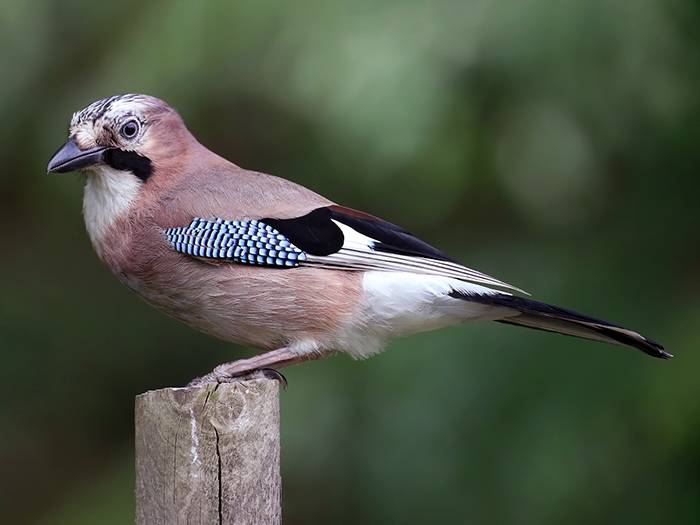
British Garden Birds Pictures: Eurasian Jay (Garrulus glandarius)
Length: 34-35cm
Wingspan: 52-58cm
Weight: 140-190 grams
Song: Eurasian Jay (Garrulus glandarius)
13. Great Spotted Woodpecker (Dendrocopos major)
The Great Spotted Woodpecker (Dendrocopos major) is a charismatic bird known for its distinctive black and white plumage, with a flash of red on its lower belly. This medium-sized woodpecker is equipped with a sturdy beak and a specialised tongue, perfectly adapted for extracting insects from tree bark and drilling nesting cavities. Its rhythmic drumming and loud, repetitive calls are characteristic sounds often heard in woodlands, parks, and gardens, signalling its presence and territorial claims. The Great Spotted Woodpecker’s striking appearance and unmistakable drumming make it a recognisable and welcomed sight for birdwatchers and nature enthusiasts.
One fascinating aspect of the Great Spotted Woodpecker’s behaviour is its drumming and tapping activities, which serve multiple purposes beyond foraging for food. The drumming serves as a form of communication, with males using it to establish territories and attract mates during the breeding season. Additionally, the rapid drumming produces resonant sounds that can convey information about the woodpecker’s presence and vitality to potential rivals and mates. This behaviour also plays a role in excavating nesting cavities and signalling the bird’s overall fitness and vigour.
The Great Spotted Woodpecker’s specialised anatomy enables it to thrive in its arboreal habitat. Its strong beak and shock-absorbing skull allow it to chisel into tree bark with remarkable precision, accessing hidden insect larvae and creating nesting sites. Furthermore, its zygodactyl feet, with two toes pointing forward and two pointing backwards, provide a secure grip on vertical surfaces, facilitating its distinctive climbing and clinging movements. These adaptations showcase the woodpecker’s remarkable physical attributes and its ability to exploit its woodland environment effectively.

Photos of British Garden Birds: Great Spotted Woodpecker (Dendrocopos major)
Length: 22-23cm
Wingspan: 34-39cm
Weight: 85 grams
Song: Great Spotted Woodpecker (Dendrocopos major)
14. Common Blackbird (Turdus merula)
The Blackbird (Turdus merula) is a widespread and adaptable bird species known for its melodious song and distinctive male plumage. The male Blackbird is characterised by its glossy black feathers and bright orange-yellow bill, while the female displays brown plumage with streaks and spots, often accompanied by a brown beak. This species is renowned for its rich, flute-like song, which is particularly prominent during the breeding season when males use their vocal talents to attract mates and establish territories. The Blackbird’s enchanting song and striking appearance make it a cherished sight and sound in gardens, woodlands, and urban areas across its range.
One fascinating aspect of Blackbird’s behaviour is its dietary preferences and foraging techniques. These birds are omnivorous, consuming a varied diet that includes insects, earthworms, fruits, and berries. Their foraging methods involve probing the ground with their bills to unearth invertebrates and pecking at fallen fruits and berries. The Blackbird’s adaptability and opportunistic feeding habits have contributed to its success in diverse habitats, from parks and gardens to agricultural landscapes, where it plays a role in controlling insect populations and dispersing seeds.
Blackbirds are also known for their resilience and ability to thrive in urban environments, where they have adapted to human presence and modified landscapes. They are often observed foraging for food in gardens, parks, and open spaces, demonstrating their capacity to coexist with human activities. Their adaptability and familiarity with urban settings have made them a common and cherished sight for city dwellers, adding a touch of nature’s beauty and vitality to urban landscapes.
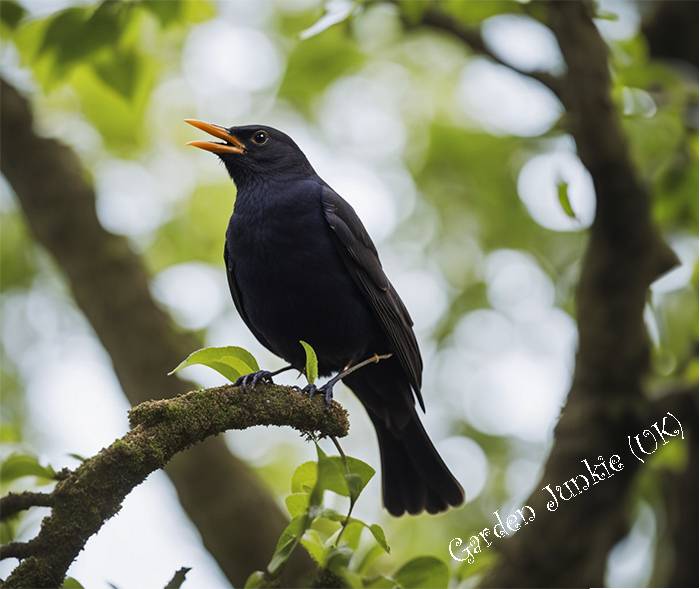
Photos of British Garden Birds: Common Blackbird (Turdus merula)
Length: 24-25cm
Wingspan: 34-38cm
Weight: 80-100 grams
Song: Common Blackbird (Turdus merula)
15. Eurasian Collared Dove (Streptopelia decaocto)
The Eurasian Collared Dove (Streptopelia decaocto) is a widely distributed bird species known for its gentle cooing calls and distinctive markings. With its pale grey plumage, the black collar on the back of its neck, and reddish feet, this dove species is a familiar sight in urban and suburban areas, as well as open woodlands and agricultural landscapes. Its soothing and rhythmic cooing calls, often described as “coo-COO-coo,” contribute to the tranquil ambience of its surroundings, making it a beloved presence in both natural and human-altered environments.
One fascinating aspect of the Eurasian Collared Dove’s behaviour is its adaptability and rapid range expansion. Originally native to Asia and parts of Europe, this species has successfully expanded its range to other continents, including North America, where it is now established as an invasive species. The Eurasian Collared Dove’s ability to thrive in diverse habitats and rapidly colonise new areas reflects its remarkable adaptability and resilience in the face of changing environmental conditions and human landscapes.
Eurasian Collared Doves are primarily granivorous, with a diet consisting mainly of seeds from grasses and cereals, as well as buds, berries, and occasionally insects. Their feeding habits often bring them into proximity to human habitation, where they forage for food in gardens, agricultural fields, and urban areas. Their reliance on seeds and grains underscores their ecological role as seed dispersers, contributing to the natural regeneration of plant species and the overall dynamics of their ecosystems.
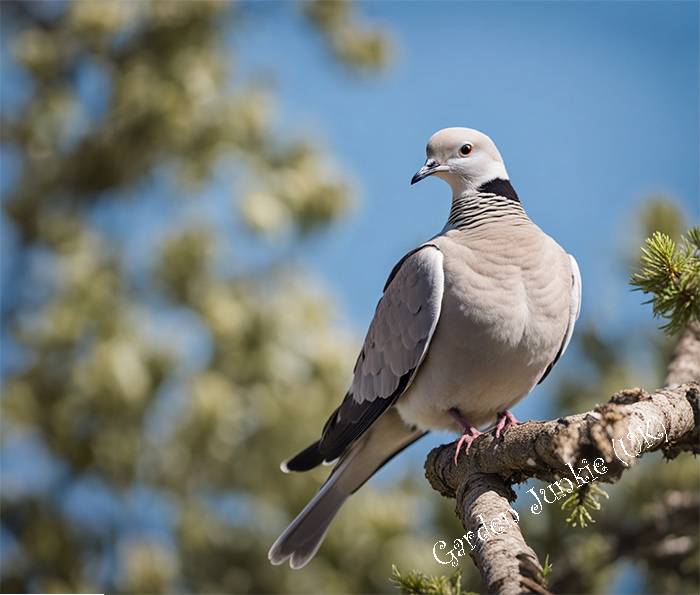
Photos of British Garden Birds: Eurasian Collared Dove (Streptopelia decaocto)
Length: 32cm
Wingspan: 51cm
Weight: 200 grams
Song: Eurasian Collared Dove (Streptopelia decaocto)
16. Greenfinch (Chloris chloris)
The Greenfinch (Chloris chloris) is a charming bird species recognised for its vibrant green plumage, which is complemented by flashes of yellow on its wings and tail. These medium-sized finches are known for their delightful, twittering song, which often includes trills and warbles, adding to the musical tapestry of their woodland and garden habitats. Their distinctive appearance and cheerful vocalisations make them a beloved sight and sound for birdwatchers and nature enthusiasts.
One fascinating aspect of Greenfinch’s behaviour is their dietary preferences, which primarily consist of seeds, particularly those from plants such as thistles, dandelions, and sunflowers. They are also known to consume buds, berries, and insects, especially during the breeding season when they seek additional protein sources for their growing chicks. Greenfinches seed-eating habits contribute to the dispersal of plant seeds, thereby influencing the regeneration and diversity of plant species within their ecosystems.
Greenfinches are social birds that often form feeding flocks, especially during the colder months when resources may be scarcer. These flocks provide safety in numbers and allow individuals to share information about food sources and potential threats. Additionally, Greenfinches exhibit intriguing courtship displays, with males performing aerial acrobatics and singing to attract potential mates. Understanding the social dynamics and courtship behaviours of Greenfinches provides valuable insights into avian social structures and mating strategies within their woodland and garden habitats.
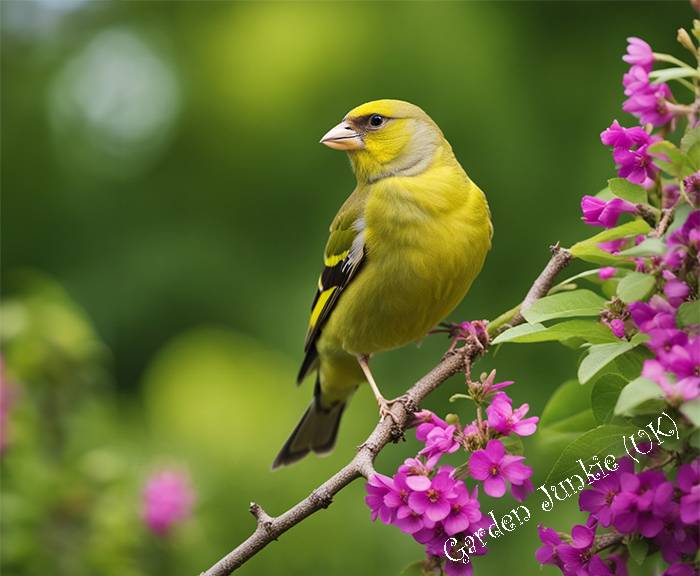
Photos of British Garden Birds: Greenfinch (Chloris chloris)
Length: 15cm
Wingspan: 26cm
Weight: 28 grams
Song: Greenfinch (Chloris chloris)
17. Eurasian Magpie (Pica pica)
The Eurasian magpie (Pica pica) is a striking and intelligent bird species that is easily recognisable by its bold black and white plumage and long, graduated tail. These birds are known for their adaptability and can be found in a variety of habitats, including woodlands, urban areas, and agricultural landscapes, across a large part of the Northern Hemisphere. Their distinctive appearance and vocalisations, which include a range of calls and mimicry of other bird species, make them a notable presence in their respective ecosystems.
Magpies are omnivorous and have a diverse diet that includes insects, small mammals, seeds, fruits, and even carrion. Their opportunistic feeding habits and scavenging behaviour contribute to their success in a range of environments. Additionally, magpies are known to hoard and cache food, a behaviour that not only helps them survive during times of scarcity but also plays a role in seed dispersal and forest regeneration. Their ecological role as both predator and seed disperser underscores their significance in maintaining the balance of their ecosystems.
Eurasian magpies are highly social birds and form complex social structures within their communities. They engage in cooperative breeding, where non-breeding individuals assist in raising the young of the dominant breeding pair. Additionally, magpies are known for their territorial behaviour and intricate vocal communication, which plays a crucial role in establishing and maintaining social hierarchies within their groups. Understanding the social dynamics and communication patterns of magpies provides valuable insights into avian social behaviour and the complex relationships that shape their interactions within their habitats.
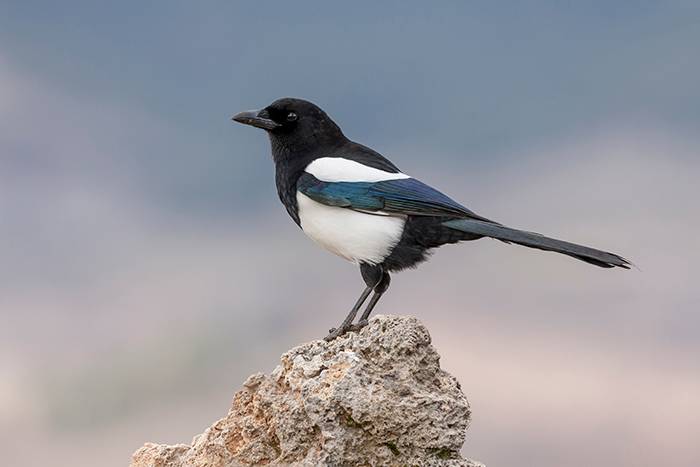
Photos of British Garden Birds: Eurasian Magpie (Pica pica)
Length: 44-46cm
Wingspan: 52–60cm
Weight: 200-250 grams
Song: Eurasian Magpie (Pica pica)
18. Yellow Hammer (Emberiza citrinella)
The Yellowhammer (Emberiza citrinella) is a distinctive passerine bird native to Eurasia, known for its striking yellow plumage and melodic song. The male Yellowhammer is particularly eye-catching, featuring bright yellow feathers on its head, breast, and belly, while the female displays more subdued plumage with a mix of yellow and brown tones. This species is celebrated for its captivating song, which is often described as a repetitive “a-little-bit-of-bread-and-no-cheese,” and is a familiar sound in agricultural and rural landscapes across its range.
These birds are often found in open countryside areas with hedgerows, woodlands, and farmlands, where they forage for seeds, grains, and insects. The Yellowhammer’s adaptability to agricultural landscapes has contributed to its historical association with farming areas, where it plays a role in controlling insect populations and contributes to the overall biodiversity of its habitat. Additionally, their distinctive appearance and melodious vocalisations have made them a cherished subject of folklore and literature, inspiring works by poets and writers throughout history.
Sadly becoming less frequent in our gardens, however, during the winter, they can be seen frequently joining groups of mixed finches and buntings. They are most likely to be attracted to gardens with corn and seeds, particularly when natural food sources are scarce in the winter and spring.
The Yellowhammer is known for its distinctive nesting habits, often building its cup-shaped nest on or near the ground, concealed within dense vegetation such as hedgerows, field margins, and woodland edges. This nesting behaviour protects their eggs and young, while also allowing them to access nearby foraging areas. Understanding the nesting preferences and habitat requirements of Yellowhammers is essential for conservation efforts aimed at preserving their populations and maintaining the health of their natural environments.
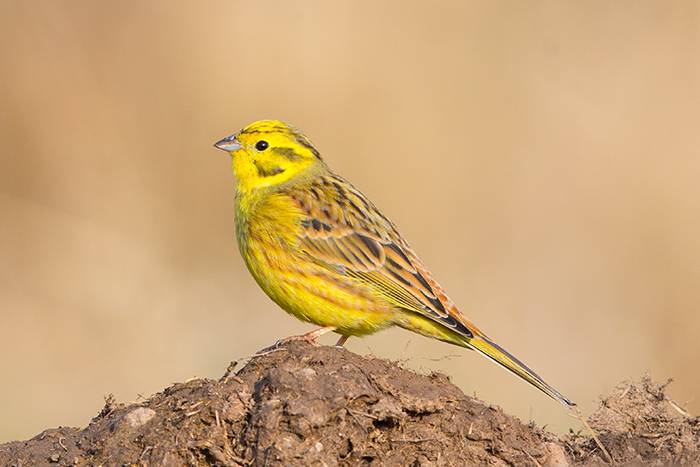
Photos of British Garden Birds: Yellow Hammer (Emberiza citrinella)
Length: 16cm
Wingspan: 23–30cm
Weight: 25-36 grams
Song: Yellow Hammer (Emberiza citrinella)
19. Jackdaw (Corvus monedula)
The Jackdaw (Corvus monedula) is a highly intelligent and adaptable member of the crow family, known for its distinctive pale grey nape and striking light blue eyes. These sociable birds are often found in a variety of habitats, including woodlands, urban areas, and agricultural landscapes, where they form large, gregarious flocks. Their inquisitive nature and acrobatic flight patterns make them a captivating sight in the skies. At the same time, their vocalisations, which include a range of calls and chattering sounds, add to the lively atmosphere of their surroundings.
One intriguing aspect of Jackdaw’s behaviour is their remarkable problem-solving abilities and tool usage. These birds have been observed using sticks and other objects to extract insects from crevices, demonstrating their cognitive flexibility and innovative foraging techniques. Their adeptness at solving complex problems and their learning capacity contribute to their success in various environments, highlighting their adaptability and resourcefulness as opportunistic feeders.
Jackdaws are known for their communal roosting behaviour, where large numbers of individuals gather at dusk to rest and socialise. These communal roosts provide safety in numbers and allow for the exchange of information about food sources and potential threats. Additionally, Jackdaws exhibit intricate courtship displays, with males performing aerial acrobatics and vocalisations to attract potential mates. Understanding the social dynamics, problem-solving abilities, and courtship behaviours of Jackdaws provides valuable insights into avian intelligence, social structures, and mating strategies within their diverse habitats.
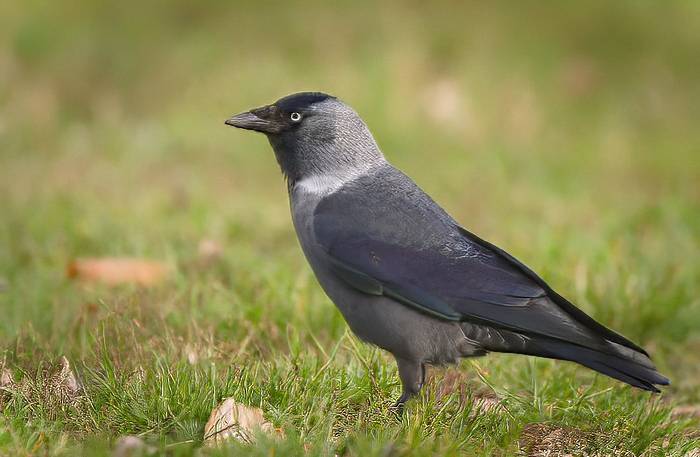
Photos of British Garden Birds: Jackdaw (Corvus monedula)
Length: 34cm
Wingspan: 70cm
Weight: 220 grams
Song: Jackdaw (Corvus monedula)
20. Carrion Crow (Corvus corone)
The Carrion Crow (Corvus corone) is a highly adaptable and intelligent bird species belonging to the Corvidae family, known for its glossy black plumage and distinctive cawing calls. These birds are widespread across Western Europe and the Eastern Palearctic, where they inhabit a variety of environments, including woodlands, farmlands, urban gardens, and coastal regions. Their adaptability to diverse habitats has contributed to their success in both rural and urban landscapes, where they play a significant ecological role as scavengers and predators.
Carrion Crows are opportunistic feeders with a varied diet that includes carrion, insects, small mammals, birds eggs, grains, and fruit. Their scavenging behaviour and role as predators contribute to the regulation of local ecosystems, particularly in agricultural areas where they help control pest populations. Additionally, their intelligence and problem-solving abilities have been demonstrated in various studies, showcasing their capacity for learning and adaptation in response to changing environmental conditions.
These birds are known for their complex social structures and communication, often forming communal roosts and engaging in cooperative breeding. Their vocalisations, including a range of calls and cawing sounds, play a crucial role in maintaining social bonds within their groups and establishing territorial boundaries. The Carrion Crow’s adaptability, ecological significance, and social behaviours make them a fascinating subject for ecological studies and conservation efforts aimed at preserving their populations and the balance of their natural habitats.

Photos of British Garden Birds: Carrion Crow (Corvus corone)
Length: 45-47cm
Wingspan: 93-104cm
Weight: 370-650 grams
Song: Carrion Crow (Corvus corone)
What is The Single Most Common UK Garden Bird?
The single most common UK garden bird is undoubtedly the house sparrow (Passer domesticus). even with some decline in certain areas. These sociable and adaptable birds are frequently observed in gardens and urban areas throughout the country, making them a familiar and prevalent sight for many people.
In 2023, roughly 1.5 million house sparrows were spotted in UK gardens between 27 and 29 January, according to people who took part in the Big Garden Birdwatch survey
What is The Difference Between a Bird Call And a Bird Song?
The primary distinction between a bird’s call and its song lies in their purpose and complexity. A bird’s call is a short, simple vocalisation used for communication within a species, often serving specific functions such as alerting others to the presence of a predator, maintaining contact with mates or offspring, or indicating distress. Calls are typically brief and may consist of chirps, squawks, or other distinct sounds.
On the other hand, a bird’s song is a more elaborate and complex vocalisation that is often associated with courtship, territorial defence, and establishing individual identity. Bird songs are typically longer and more melodious than calls, often incorporating varied notes, trills, and repetitions. Songs are used to attract mates, signal ownership of a territory, and communicate with other individuals of the same species.
In summary, while both calls and songs are forms of vocal communication used by birds, calls are generally simpler, shorter, and serve specific immediate functions, while songs are more intricate, longer, and are often associated with reproductive and social behaviours.
Note: All the birds identified on this page have their associated songs not calls.
FAQ’s
How Can I Attract Different Species of British Garden Birds To My Garden?
You can attract different species of British garden birds to your garden by providing suitable food, water, shelter, and nesting opportunities. Bird Baths, Bird Tables and Bird Nesting Boxes are a good start.
Each species has its preferences, so it’s helpful to research the specific needs of the birds you want to attract.
How Can I Identify Different Species Of British Garden Birds?
What Are Some Common Mistakes To Avoid When Identifying British Garden Birds?
Common mistakes to avoid when identifying British garden birds include relying solely on colour, overlooking seasonal variations in plumage, and misjudging a bird’s size and shape.
It’s important to consider multiple characteristics and consult reliable resources to make an accurate identification.
Conclusion
Identifying British garden birds can be a rewarding and enjoyable activity for bird enthusiasts. There is a diverse array of avian visitors that can be observed in garden settings across the UK.
By familiarising oneself with the unique features, behaviours, and vocalisations of these birds, individuals can gain a deeper appreciation for the natural beauty and biodiversity present in their own outdoor spaces.
Whether it’s through birdwatching, providing bird feeders and nesting boxes, or simply enjoying the sights and sounds of these feathered visitors, the presence of garden birds adds a touch of wonder and connection to the natural world right at our doorsteps.
